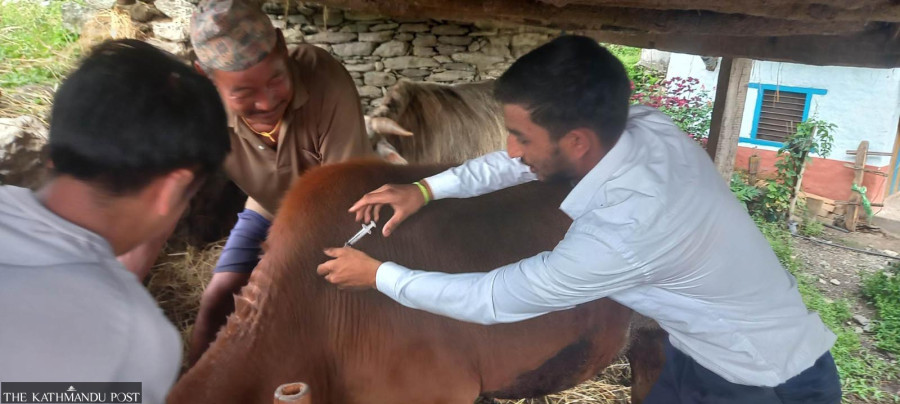National
Nepal seeks virus seed from India to produce lumpy skin vaccine
More than 50,000 cattle have died and over 1.1 million have been infected by the viral disease in Nepal since April.
Post Report
Nepal has requested India for a master seed virus of lumpy skin disease, for the production of a vaccine within the country.
Without the master seed virus, which is pure, safe and immunogenic, vaccine production is impossible, officials say.
“We have the capacity and expertise to produce animal vaccines within the country and for that, we need a master seed virus,” said Dr Chandra Dhakal, information officer at the Department of Livestock Services.
“The Minister for Agriculture and Livestock Development during his recent India visit made a request to his counterpart for the master seed virus for vaccine production and vaccine doses to deal with the ongoing spread of the infection,” said Dhakal.
Lumpy skin disease, also called LSD, is caused by a virus, an infectious disease that primarily affects cattle. The virus, which is from the family Poxviridae, mainly spreads through blood-sucking vectors—ticks, mites, and mosquitoes.
According to Dhakal, Nepal has been producing more than 56 million doses of 13 different types of animal vaccines in the country and has been exporting them too.
“We have also furnished a concept paper as sought by the Indian authorities for vaccine production,” he added.
Officials at the department said that the government has also requested China for free vaccine doses for lumpy skin disease.
So far, more than 50,000 cattle across the country have died and more than 1.1 million are infected by the highly contagious viral disease since the outbreak began in April.
Due to the widespread infection in cattle, farmers have incurred heavy losses which include deaths of animals, decline in dairy production, and their consequent impact on farming. It takes 20 to 30 days or more to get animals infected with the viral disease cured. Officials concede that farmers in the hill districts lost more of their oxen because they continued putting the sick animals to work due to lack of information about the disease.
Officials conceded that some animals might have died of vaccination at the time of infection due to the double impact—infection of virus and stress effects of the vaccination.
Dhakal said that his office has written to the ministry to provide relief and compensation to the affected farmers.
“Once the government announces relief for the affected farmers, more farmers will come forward to report the deaths and infections,” he said. “But unless the government takes a decision, we cannot promise relief.”
Prime Minister Pushpa Kamal Dahal has said that his government is working seriously to contain the spread of the lumpy skin disease.
Veterinarians say the infected cattle have acute fever, discharge from the eyes and nose, salivation, and soft blister-like nodules all over their bodies.
After contracting the infection, the animals immediately start losing weight due to difficulty in eating, which ultimately affects their milk yields. Pregnant cows and buffaloes could suffer a miscarriage and the infected animals could sometimes die.
As the virus is not zoonotic, the chances of humans getting infected from the disease are slim, say experts.




 16.2°C Kathmandu
16.2°C Kathmandu






%20(1).jpg&w=300&height=200)






